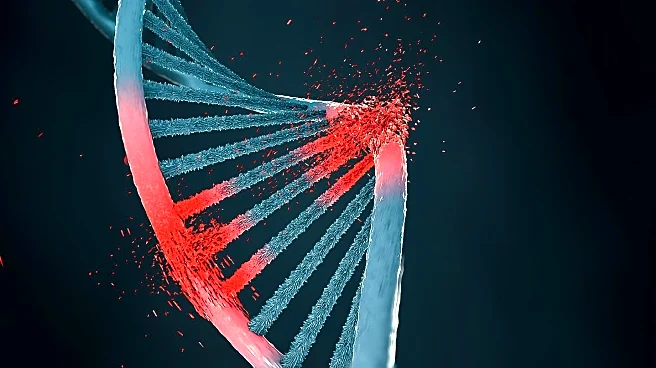What's Happening?
Northwestern University chemists have developed a new nanostructure that significantly improves the delivery of CRISPR gene-editing tools. These structures, known as lipid nanoparticle spherical nucleic acids (LNP-SNAs), encapsulate CRISPR components such as Cas9 enzymes, guide RNA, and DNA repair templates within a protective DNA shell. This innovation enhances the efficiency of CRISPR delivery into cells, tripling the effectiveness compared to standard lipid particle systems used in COVID-19 vaccines. The LNP-SNAs also reduce toxicity and increase the success rate of precise DNA repairs by over 60%. The study, published in the Proceedings of the National Academy of Sciences, highlights the potential for safer genetic medicines and emphasizes the importance of nanomaterial structure in determining potency.
Why It's Important?
The advancement in CRISPR delivery methods could revolutionize genetic medicine by enabling more efficient and safer gene editing. This development is crucial for treating genetic disorders and diseases, as it addresses the challenge of delivering CRISPR machinery into specific cells and tissues. The improved delivery system could expand the range of cell and tissue types accessible for gene editing, potentially leading to breakthroughs in medical treatments. The research underscores the significance of structural nanomedicine, a field that could unlock CRISPR's full therapeutic potential, thereby impacting the biotechnology industry and healthcare sector.
What's Next?
The research team plans to validate the LNP-SNA system in various in vivo disease models, aiming to adapt the platform for diverse therapeutic applications. Northwestern's biotechnology spin-out, Flashpoint Therapeutics, is working to commercialize the technology, with intentions to move it swiftly toward clinical trials. This progression could lead to new treatments for genetic diseases, influencing future medical practices and drug development strategies.
Beyond the Headlines
The development of LNP-SNAs highlights ethical considerations in genetic medicine, such as the potential for gene editing to alter human genetics fundamentally. It raises questions about accessibility and regulation of such powerful technologies, which could lead to societal shifts in how genetic diseases are perceived and treated. The innovation also emphasizes the importance of interdisciplinary collaboration in advancing medical technologies.











